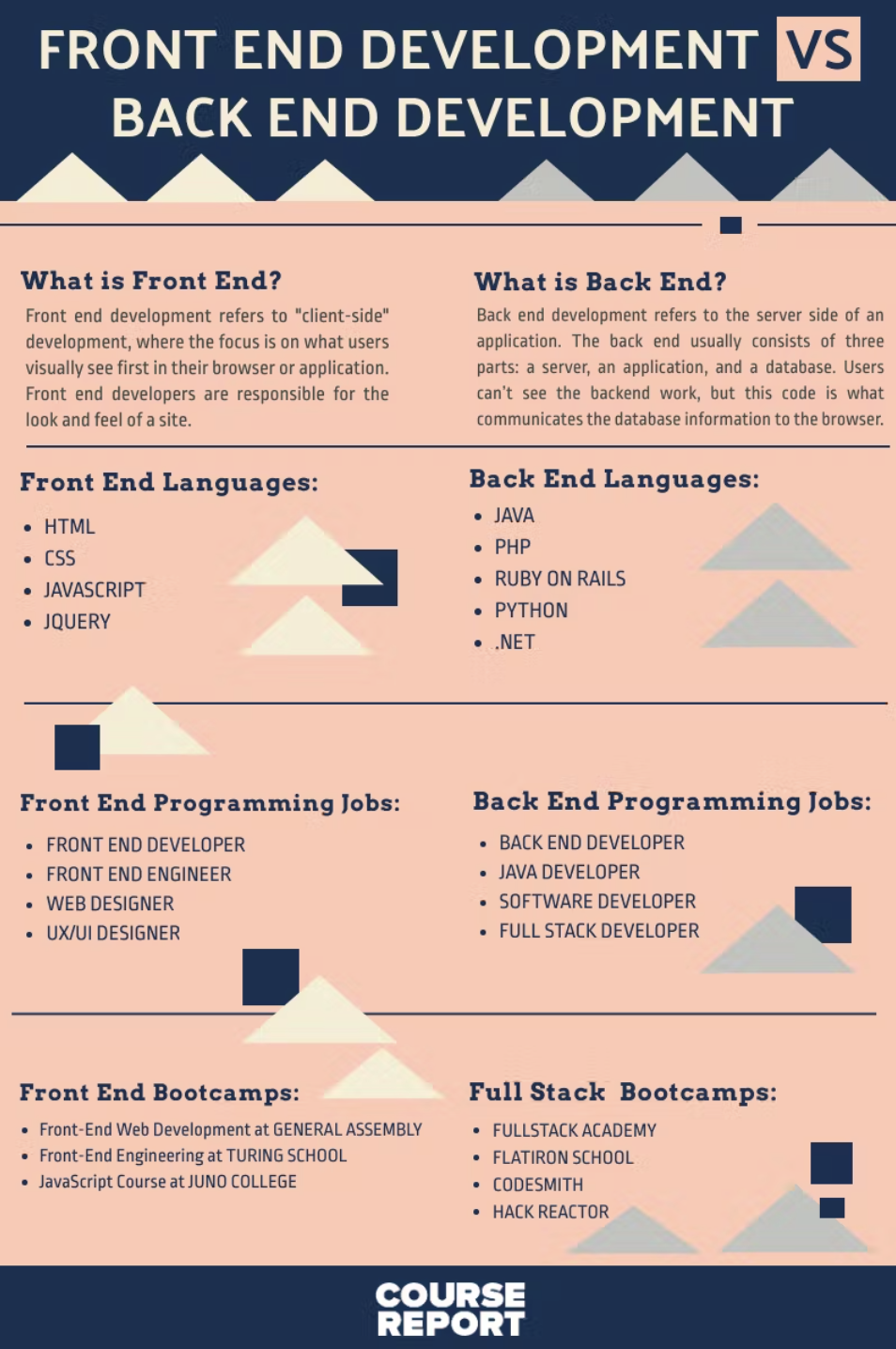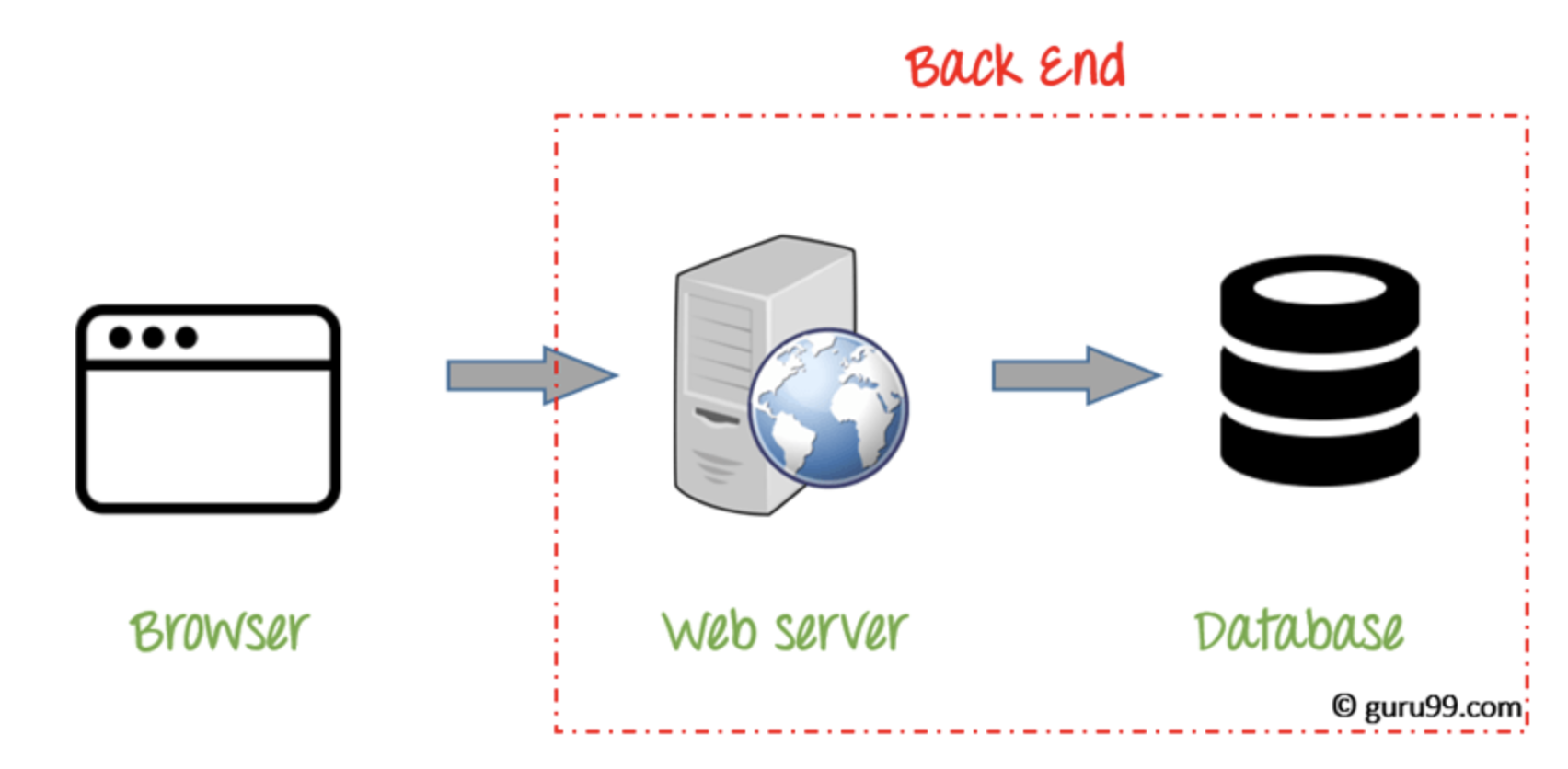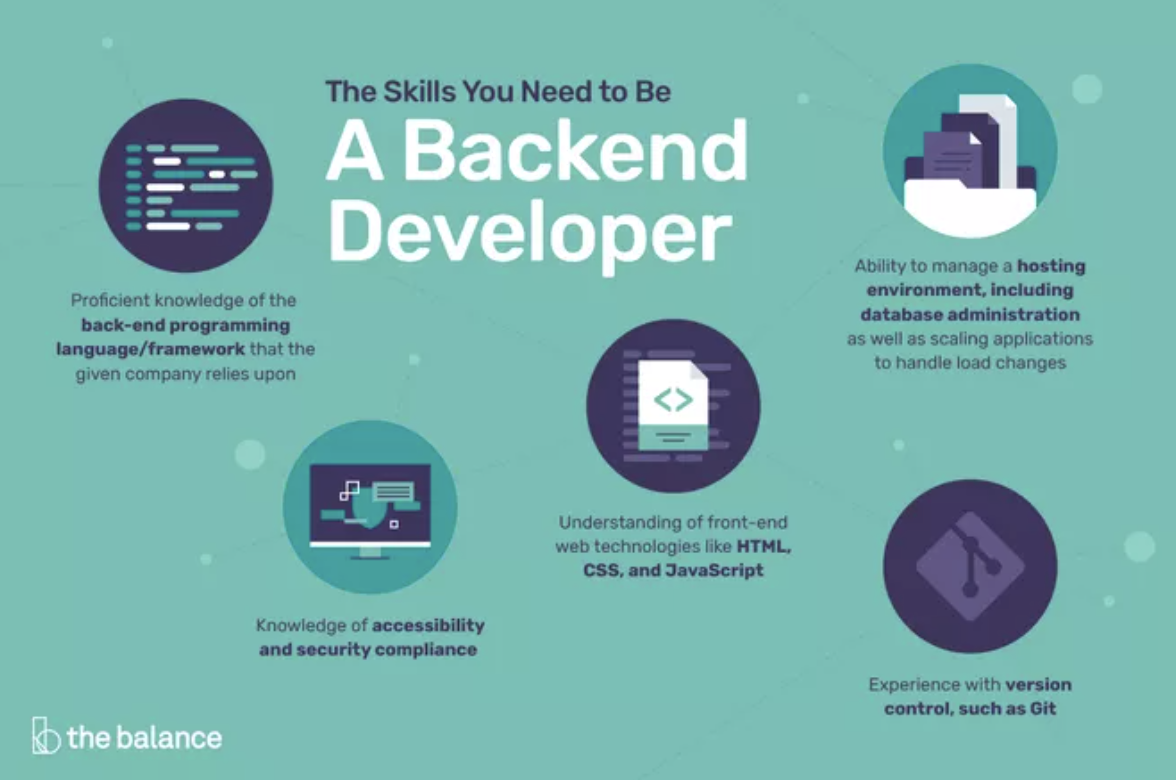Front-End vs. Back-End Development: What’s the Difference?

In this article
Have you ever noticed that some websites seamlessly translate to a mobile device, while others clearly don’t? This isn’t a matter of chance or happenstance. It’s front-end and back-end development in action, and when the two work together, it’s a real thing of beauty.
But while both front-end and back-end development are dependent upon each other, the two are actually distinct specialties. Each has its own skillset that’s required, and depending on your own interests, you may be better suited for one rather than the other.
Want to learn more about the difference between front-end and back-end development? Then let’s dive right in.
What’s the Difference Between Front-End and Back-End Development?

Front-end development is concerned with the visible elements of a website or application: What the users see, and what they interact with. Back-end development manages the inner workings, such as how the data the users’ input is processed and stored, and how the website communicates with servers and other sites.
Front End vs. Back End Development
Interested in a career in web development, but not sure what specialty matches your own skillset? Not to worry. Below, we’ll outline the differences between the two.
What Does Each Mean?
Before looking at the roles of the developers themselves, let’s first cover the fundamentals of front and back-end development.
What Is Front-End Development?
Everything you see and interact with when you use a website is built by the front-end developer. From animations to buttons and drop-down menus to colors, every front-facing, visual aspect of a website is displayed and functioning as it should be through the use of front-end code and tools.
Front-end development teams work closely with UI designers to transform assets and designs for the user interface into working websites—in other words, the UI designer creates a pretty picture of a button, and front-end development techniques are used to turn it into a working button. A UI designer chooses and determines the aesthetics of a product, but the front-end developer is the one who implements them.
Front-end development includes making sure a website is displayed properly on multiple platforms like web, mobile, etc., so when you’re reading a blog on mobile and half the text has disappeared off-screen—that’s a front-end development mishap!
Pictured above: Side-by-side comparison of a website that hasn’t been adjusted to be responsive on mobile devices.
What Is Back-End Development?
If front-end development takes care of everything you can see on a website, then back-end development takes care of everything you can’t see. Whereas front-end developers have much in common with fields like graphic design, back-end developers tend to work with servers, databases, and APIs. You may also hear a back-end developer referred to as a server-side developer.
For example, a front-end developer builds the fields so you can input your card details on an online shop, but a back-end developer ensures that a safe place is created for those details to be stored and used properly. Back-end development involves building and integrating all these systems together.
Get To Know Other Software Engineering Students
Abdelkareem ElSharief
Software Engineer at Bread
Jack Mayer
Software Engineer at Whitepages
Julia Ayres
Software Engineer at Northspyre
Goals of Front-End and Back-End Development
Of course, both back-end and front-end development shares the ultimate goal of creating a smooth, functioning website that delivers on what the clients and users want. But to achieve this, each needs to focus on their own separate objectives.
What Is the Goal of Front-End Development?
The main goal of front-end development is designing a website that efficiently covers everything the client needs, making sure everything displays correctly, and ensuring all interactable elements are functioning properly. This includes making sure the site is optimized for use on all platforms like PCs, smartphones, and tablets.
What Is the Goal of Back-End Development?
The main goal of back-end development is to create a back-end system that ensures the ultimate purpose of the site is fulfilled and that all data received is processed and stored safely. For example, if the site is an online store, then its ultimate purpose is to deliver goods to the users in exchange for money. If the site is a learning platform, then its ultimate purpose is to provide users with educational content and record and store their progress.
Examples
Let’s take a look at what this all looks like in practice.
What Are Some Well Known Examples of Front-End Development?
Front-end development covers a lot of ground, but here are a couple of examples that you’ll definitely be familiar with.
- UI (user interface). The menus you navigate, the buttons you press, and the images you see while using a website are all part of the front-end development.

- Forms. Areas for you to input information were also designed and created by a front-end developer.
What Are Some Well-Known Examples of Back-End Development?
Back-end development is not as visible, but there are some well-known examples that you’ll probably recognize.
- Infrastructure. A back-end developer will build the templates and infrastructure for features that can be later edited to add content. For example, different courses on a learning platform will be managed by the same infrastructure, which course authors can then edit to create their curriculum.
- Saved information. When you make an account on a site and allow it to store personal information, a back-end developer has built the systems to process that data and store it safely
Front-End vs. Back-End Developers
Now let’s move on to the details of what a front-end vs. a back-end developer does, and the skills required to enter these fields.
Job Descriptions
While both front-end and back-end developers will work on the same project, the job descriptions for each position will look fairly different. Let’s have a look at some typical examples of both.
What Does a Front-End Developer Do?

A typical front-end development role will include responsibilities like:
- Liaising with clients to identify their needs and propose effective solutions.
- Developing the design and structure of web pages.
- Designing with user experience, aesthetics, and brand consistency in mind.
- Optimizing code to ensure maximum speed and scalability across the site.
- Building readable code that can be reused, refactored, and maintained by other developers.
- Utilizing JavaScript and a variety of libraries and frameworks to create websites.
- Performing extensive testing to ensure full functionality across the site.
What Does a Back-End Developer Do?

A typical back-end development role will include responsibilities like:
- Cooperating with front-end developers to establish and achieve objectives in compliance with the client’s needs.
- Utilizing APIs to provide the required third-party services and features on the website.
- Designing and implementing data storage solutions and accompanying data protection/security protocols.
- Integrating user-facing elements with back-end logic.
- Building readable code that can be reused, refactored, and maintained by other developers.
- Optimizing code to ensure maximum speed and scalability across the site.
- Utilizing a variety of back-end languages, libraries, and frameworks to create websites.
Skills and Requirements
Now that we know what each kind of developer does, let’s look into some of the skills and requirements needed for each.
What Are the Skills Needed To Become a Front-End Developer?
To become a front-end developer you will need the skills and requirements such as:
- A degree in computer science or other related fields.
- Proficiency in JavaScript, HTML, and CSS (Cascading Style Sheets).
- Familiarity with SEO concepts and popular trends within the industry.
- Experience with the key principles of web design and structure.
- Outstanding verbal communication and interpersonal skills.
- Excellent problem-solving and critical thinking skills.
What Are the Skills Needed To Become a Back-End Developer?

The average job advertisement for a back-end developer will list skills and requirements such as:
- A degree in computer science, computer programming, or another similar field.
- Proficient knowledge of at least one back-end programming language (such as Python, Ruby, PHP, C++, etc), and familiarity with others.
- Good understanding of server-side logic and data management protocols.
- Good understanding of data protection and security principles.
- Developing, managing, and utilizing back-end APIs across multiple services.
- Knowledge of multiple RDBMSs (relational database management systems) such as Oracle, SQL Server, etc.
- Knowledge of multiple web servers such as Apache, Microsoft-IIS, etc.
- Excellent communication, problem-solving, and critical thinking skills.
Languages & Tools

Source – DTeam
Web developers use a variety of languages and tools to create websites. Developers will often have one primary language they consider themselves an expert in, and usually develop their knowledge of secondary languages as the need arises during projects.
Here are the most popular back-end and front-end developer languages, frameworks, and libraries:
Front End Developer Languages
Front-end devs generally focus on the same set of three languages and then expand into frameworks. Here’s what you’ll be working with:
- JavaScript (This language is huge—over 97% of websites use JavaScript.)
- HTML
- CSS
Front End Developer Libraries & Frameworks
Libraries and frameworks are collections of various resources for developers to make use of. They include resources such as pre-written code, subroutines, documentation, and configuration data. Oftentimes, when you start looking for a job in the industry, you may be expected to know at least one of these frameworks.
Common libraries and frameworks you’ll use as a front-end developer include:
- SASS. This is an extension of CSS which can deal with more complex decision-making tasks and help save time and effort.
- AngularJS. This is a structural framework that extends HTML’s syntax to make it easier to build web applications.
- React.js. This is a JavaScript library for building interactive user interfaces.
- JQuery. This is a JavaScript library that uses an API to simplify HTML features across multiple browsers.
- Flutter. This is a framework for building, testing, and deploying applications from a single codebase.
Back-End Developer Languages
Back-end developers generally have more choice and freedom when it comes to specializing. Here are some of the most frequently used back-end languages:
- Java
- PHP
- C++
- Python
- JavaScript
- Node.js
Back End Developer Libraries and Frameworks
Back-end developers also use libraries and frameworks such as:
- Django. This is a high-level Python web framework that allows developers to create web apps with less code.
- Spring. This is a framework for building web applications and focuses on minimizing upfront configuration.
- Ruby on Rails. This is a full-stack framework for building web applications on the front-end and back-end.
- Express. This is a Node.js web application framework.
- Atlassian. This company makes tools for developers to ease their workload.
Salary
Accordingly to Glassdoor, back-end developers make slightly more than front-end developers. Let’s break it down:
How Much Can a Front-End Developer Make?

Glassdoor lists the median base salary for a front-end developer at $88,528 annually (as of May 2022), with junior roles at an average of $52,853.
How Much Can a Back-End Developer Make?

For back-end developers, the median base salary is listed as $95,112 annually, with an average of $65,400 for junior roles.
Career Path
While a formal education in computer science used to be the beginning of most career paths in the tech industry, that is no longer the case today. Let’s break down the career paths for front-end and back-end developers.
Study
Whether you choose college, self-study, or online courses and bootcamps, the first step in any web development career is equipping yourself with the basic skills and knowledge. An introduction to UX design course is a great place to start.
For front-end developers, this means getting to know JavaScript, HTML, and CSS, and studying the design and structural principles upon which websites are built.
For back-end developers, it means finding a back-end language to specialize in and learning the basics of servers, databases, and APIs.
Portfolio and Experience
Once you understand the basics, it’s time to start building a portfolio that can showcase your skills, your learning trajectory, your passion, and your motivation. Whether you’re looking for a job as a front-end developer or a back-end developer, your portfolio will demonstrate what you can do and what kind of worker you are.
Landing a Junior Position or Internship
When you finish college, coding bootcamp, or feel your self-study has progressed enough to start working, it’s time to find your first junior role. Keep an open mind and take whatever opportunities come your way!
Senior Roles
When you have some experience under your belt, you can start looking for more senior positions. Often, it helps to add specializations or certificates to your resume to get there.
Front-End vs Back-End vs Full Stack Developer: What To Choose and Why?
Many budding web developers will begin their careers by studying the basics of both front-end and back-end development. Some even go on to study both and become full-stack developers—developers who can code the front-end and back-end of a website. If you’re having trouble deciding where you want to specialize, then consider the following:
Consider a Front-End Developer Career if…
If you find yourself mostly enjoying the creative and aesthetic design process when building the visual elements of a website.
Consider a Back-End Developer Career if…
If your interests lean more towards data management: working with databases, server-side logic, and APIs.
Consider a Full-Stack Developer Career if…
If you find yourself enjoying both aspects equally, and are passionate about ensuring the two sides work together seamlessly to create a great final product. A full-stack developer salary tends to be higher than salaries for back-end or front-end developers.
Since you’re here…
Considering a career in software engineering? We’ll help you build a CV that rivals experienced software engineers in 9 months flat with our Software Engineering Bootcamp. If you’re still mulling, try our free software engineering learning path and check out our salary guide to see what you could be making.




![How To Become a Software Engineer [2022 Career Guide]](https://www.springboard.com/blog/wp-content/uploads/2020/07/how-to-become-a-software-engineer-2022-career-guide-380x235.jpg)
